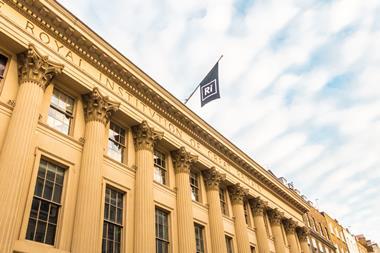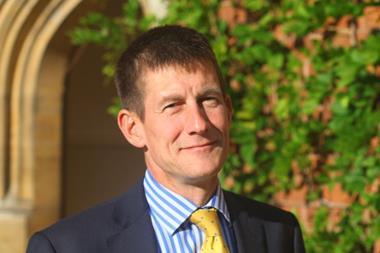If the Royal Institution is to have a future, it cannot be separated from its past, says Mark Peplow
Sitting at the top of the Royal Institution’s Faraday lecture theatre induces a certain giddiness. The vertiginous gradient of its terraces is certainly a factor, but so too is the anticipation that some mystery of nature is about to be illuminated. After all, this is where Humphry Davy and Michael Faraday once held court; where ten elements were discovered; where the first electric motor was built.
Tens of thousands of visitors experience the same thrill every year, and millions more tune in to the Royal Institution (RI) Christmas lectures, which began in 1825 and have been televised since 1966.
Now the RI is considering selling its home, 21 Albemarle Street, the London site the RI has occupied since shortly after its foundation in 1799, and one of the world’s most important scientific heritage sites. The chair of the RI’s board of trustees, Richard Sykes, announced on 17 January that measures to rescue the RI’s finances may include ‘disposing of some or all of its Albemarle Street property’.
Solvent loss
The news shocked many, but the financial straits leading to this announcement have been worsening for years. In 2007, the RI’s report to the Charity Commission was buoyant, detailing the sale of three other properties on Albemarle Street for £14.5 million, a ‘significantly higher’ sum than expected. These funds enabled badly needed refurbishment work as part of a five-year plan to improve public access to the RI’s scientific collection and develop its rooms into an events business.
A year later, however, the building work was delayed and over budget, and fundraising was down, although the Heritage Lottery Fund had chipped in £4.5 million. In 2009, the first year of operating in its refurbished premises, the RI recorded a deficit of over £2 million.
Worse was to come in 2010 – the RI’s annus horribilis. Opening the building to the public every day, for free, had proved more expensive than expected; potential donors were spooked by the managerial turmoil that resulted in the redundancy of the director, Susan Greenfield. Debts grew, and the institution increasingly relied on a loan, then an overdraft, secured against 21 Albemarle Street. Last year, with business forecasts from 2011 indicating the ‘possibility of a breach of covenants’ on those debts, the trustees began to consider options, ‘including realising assets and possible joint activities with other organisations’. In other words: sell or let the RI’s sole remaining property, or look for a bail out.
Science lives there
Commentators have suggested that the RI could raise money by hiring out its glorious rooms, or by establishing partnerships with the Royal Society, the Science Museum or the Wellcome Trust. But that is exactly what the RI’s management has been trying to do for at least two years, without success. Perhaps the lack of interest is because the RI’s unique selling points, and its vision for the future, has been communicated poorly. That would be damning enough for an organisation focused on communication, but I hope it is the case because the alternative conclusion would be far worse: that nobody sees the point of the RI any more.
I know from personal experience that the institution’s mission is as important as ever. After leaving chemistry research, my first job was at the RI’s Science Media Centre, which enabled me to sneak in to dozens of lectures, packed with audiences of excited schoolchildren watching explosive demonstrations. Visitors’ glowing feedback and the recollections of countless researchers inspired to pursue science by such events attest to the RI’s value.
That said, questions do remain (though few are asking them) about the continued presence of the Davy Faraday Research Laboratories on the top floor of the building. I have no doubts about the tremendous value of the nanotechnology research conducted there, but I do have some about hosting it in a historic Mayfair property with a serious debt problem.
11th hour
Some argue that if the RI can no longer afford its lavish Mayfair site, it should sell up and continue its outreach from a more modest base. Others suggest the government could ‘save it for the nation’ – something that would only increase the RI’s long-term financial vulnerability by making it dependent on the largesse of politicians.
Instead, the campaign to save the RI’s home should focus on winning long-term endowments to secure its independent future. Sykes’ very public admission of the RI’s difficulties may have been a last-ditch effort to enable this by igniting public feeling. If so, I hope that the resulting momentum will energise the fundraising campaign, and spark fresh negotiations with potential partners. If any pride remains to be swallowed, it must be gobbled up immediately, for the RI’s present day activities are inseparable from its heritage. Its location enriches its outreach work, which in turn makes that history freely available to all. Only by preserving the bond between the two can the RI continue to do what it does best: inspiring the child in all of us.
Mark Peplow is a freelance journalist based in Cambridge, UK












No comments yet